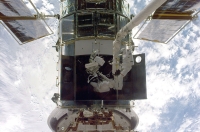Repair of Space Telescope Imaging Spectrograph
The Space Telescope Imaging Spectrograph (STIS) was installed on the Hubble Space Telescope during Servicing Mission 2 in 1997. STIS stopped functioning in August 2004 due to a power supply failure, and was in safe mode pending the planned repair during Servicing Mission 4. The repair restored power to one of the two failed distribution channels. The FixTo repair STIS, astronauts replaced the low-voltage power supply board that contains the failed power converter. The fix was straightforward, but required diligence as the instrument was not built with space surgery in mind. Engineers, therefore, developed a number of special tools and devices that aided the astronauts and ensured no debris entered the instrument. A nail-biting moment occurred when the astronauts had to conquer a stubborn bolt on a handrail attached to STIS before taking on the tall task of removing 111 screws to access the instrument’s power supply card. After detaching the panel (with the capture plate and fasteners attached), astronauts removed the failed power supply card and clicked in the new one, much like replacing a circuit board on a computer. A new, simplified panel was then installed over the open electronics cavity — only this time the 111 fasteners were not necessary. By throwing just two lever-like latches, the astronauts locked the new panel securely into place. Future ScienceWorking side by side, the COS-STIS tandem offers a full set of spectroscopic tools for astronomers. A look at STIS’s scientific past offers a glimpse of future endeavours:
LinksFact Sheet (PDF) |
